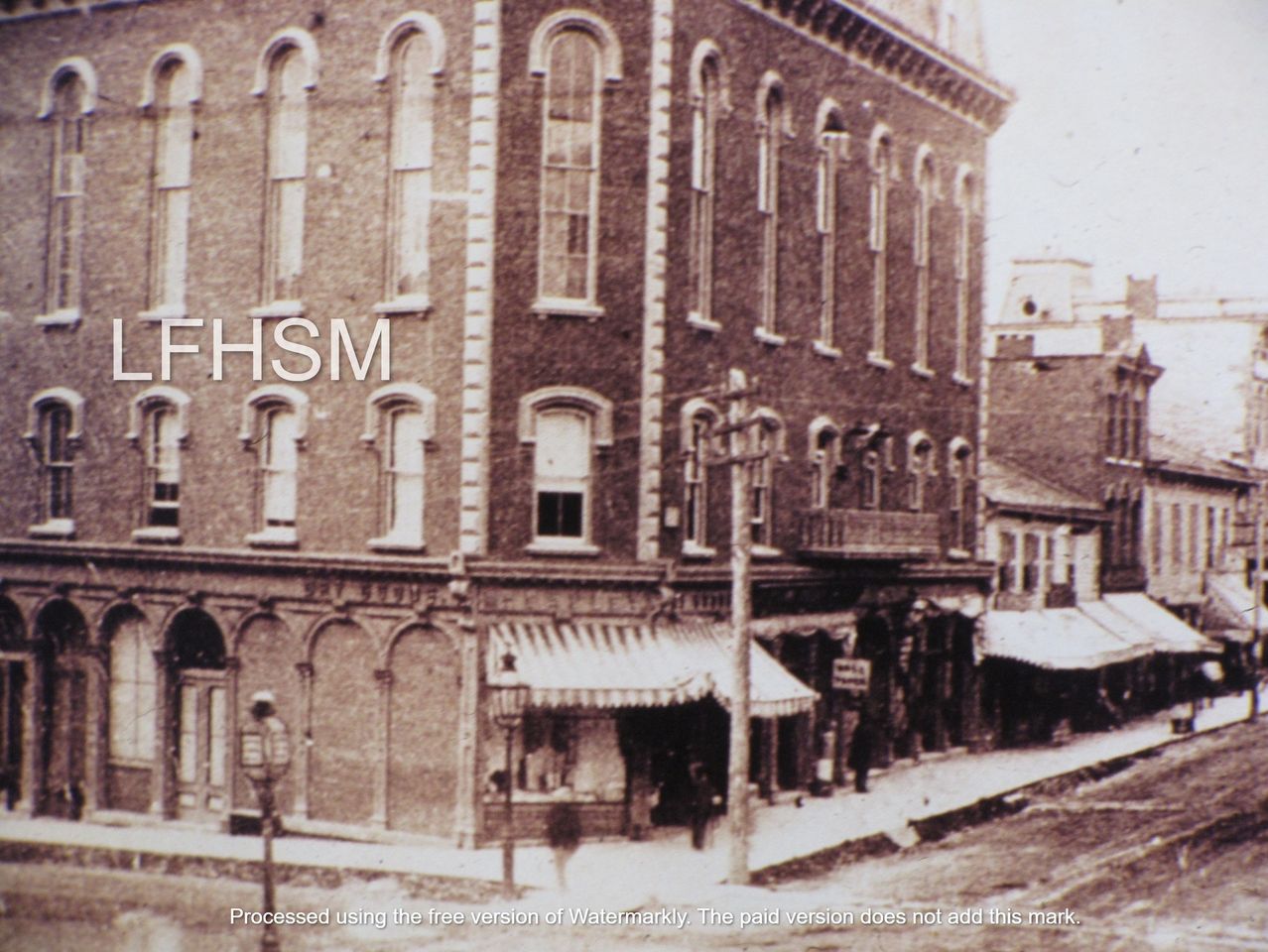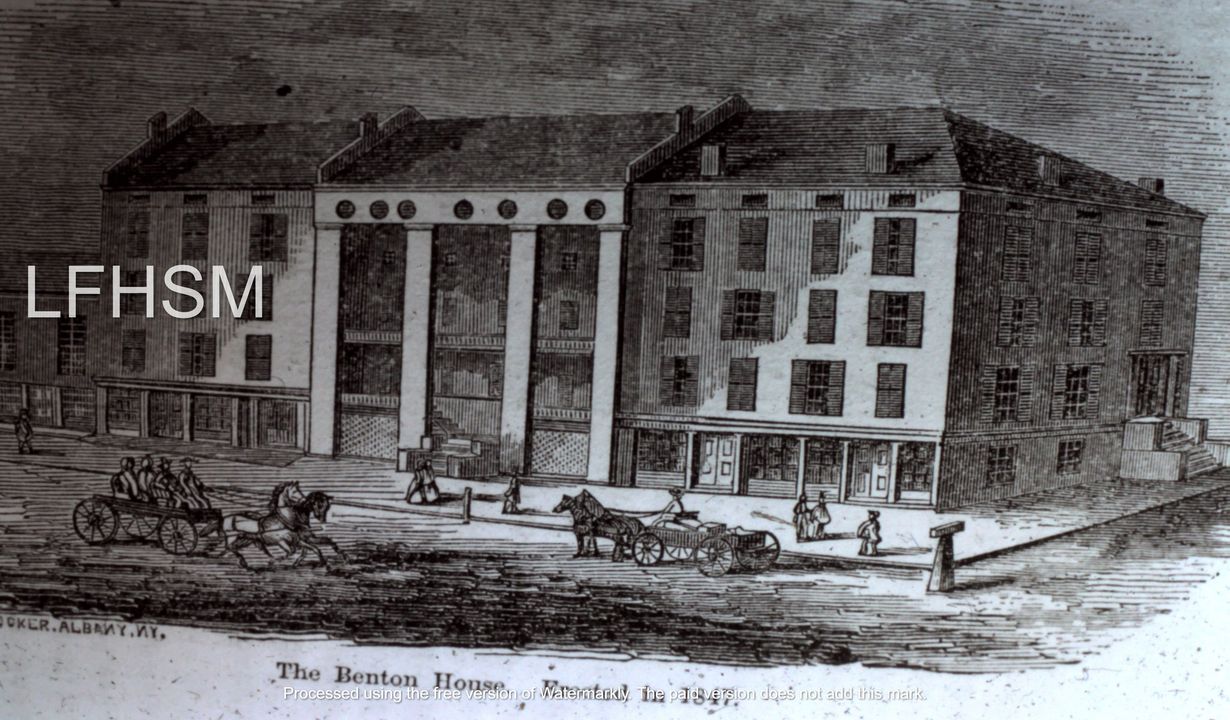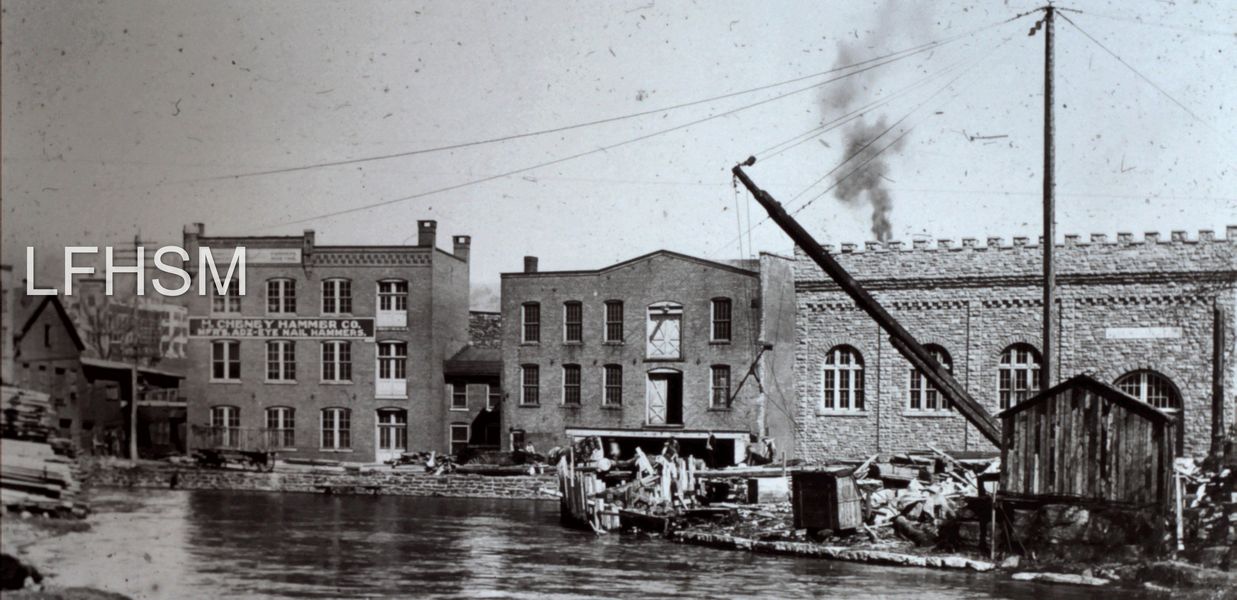On APRIL 7, 1899, the reserved seat sale was opened for the concert by the mandolin and banjo club of St. Lawrence University at the Skinner opera house.
“Prior to the concert, a full-dress rehearsal will be given to the old folks of the city.”
April 7, 1899, Cooney Archives

1870 Skinner Opera House | From the Cooney Archives: THIS DAY IN HISTORY …” ON JUNE 21, 1870, recently, a new block at the corner of Main and Second Streets was erected by Hon. William I. Skinner and designed by J. E. Warren of Rochester. The three-story building, with a beautiful Mansard roof, stretches 120 feet on Second Street and 70 feet on Main Street. The structure contains 700,000 bricks made by Mr. Skinner. It will be known as the Skinner Opera House | The building was removed by Urban Renewal in the early 1970s.
According to the Cooney Archives: THIS DAY IN HISTORY … “ON MARCH 3, 1870, the opening of the Skinner Hall ushered in an era of entertainment consisting of traveling shows, dances, G.A.R. meetings, and walking matches. Highlights of the day included a parade in the afternoon and dancing in the evening.
According to the Cooney Archives: THIS DAY IN HISTORY … “ON JUNE 21, 1870, recently, a new block at the corner of Main and Second Streets was erected by Hon. William I. Skinner and designed by J. E. Warren of Rochester. The three-story building, with a beautiful Mansard roof, stretches 120 feet on Second Street and 70 feet on Main Street. The structure contains 700,000 bricks made by Mr. Skinner. It will be known as the Skinner Opera House.”
529-535 EAST MAIN STREET
Prior to the opera house being built on village lot # 5, on the south side of Catherine Street (East Main Street), at the intersecting corner to Second Street, it had also been known through the years as: presently the M&T Bank; the department store of M. Lurie & Co.; the City “ Lintonian” Theater; the D & J Petrie Company, David & Joram Petrie’s mercantile; and the Eben Briton property, with Briton owning the Briton House kitty-corner across the street, that was in the present-day location of the Snyder Apartments. The premises had been subjected to a yearly land lease of a beaver pelt or three Spanish milled dollars in perpetuity to the village of Little Falls since 1780, when the Ellice Estate added this clause to the land deed, with the ownership of the land at Little Falls belonging to the estate. Judge Nathaniel Benton removed this clause in the 1780 property deed on the 1st of December in 1865, when Honorable William I. Skinner purchased the lot. After the death of Eben Briton, Skinner attended a real estate auction held at the Benton (Briton) Hotel for the sale of village lot #5, being the highest bidder and claiming the property for $9,200. (B86/P398).
HOUSE OF STONEMASONS: THE BOYER FAMILY
The Skinner Opera house was built by the Boyer Construction Company, being Joseph Boyer Sr. and his sons, Joseph Jr. and Leonard, along with his grandson Horace. The Boyers were employed as stonemasons, with Joseph Sr. having apprenticed in the trade of stonemasonry under his father, Colonel Leonard Boyer, with the trade spanning four generations of Boyers.
The Boyer’s erected many important structures, bridges, and homes within the area. Present-day structures that can be viewed are: the historic four arch stone bridge at Newport, NY; 542 East Gansevoort Street (the present-day Wagner home); and the old Boyer family farmstead (the former home of Keith Davy) at 49 Jackson Street.
HONORABLE WILLIAM IRA SKINNER
William was the son of Elizabeth Alling and Josiah Skinner, who were early pioneer villagers, who settled at the falls on Western Avenue (West Main Street) before 1800. He was born at Little Falls on the 24th of October in 1812.
William was married for fifty-seven years to Dinah McChesney (1814-1892) of Fall Hill, whom he married in 1834. They had six children over the course of their marriage, namely: Caroline (1836-?); Henry (1842-1919); William Jr (1849-1888); Samuel (1853-1934); Horace (1854-?); and Margret (1864-1899), whose daughter Margaret married Joshua Judson Gilbert.
Josiah was of moderate means financially, being a merchant of tinware and stoves, encouraged William to seek employment at an early age. His first job was holding candles in the evenings for Daniel Stewart, who was the village wainwright, (building carts and wagons) so that Daniel could work after the sun went down. William attended local schools during the winter months and during the summer months, up to the age fourteen, he was employed on the Erie Canal as a hoggee, where he led a team of horses to pull canal boats along the canal.
At fourteen, with the help of William G. Milligan, the then president of the Herkimer County National Bank (the 1833 Old Stone Bank that houses the LFHSM), William was apprenticed to the cabinet maker Gordon Stevenson, along with another Little Falls lad, Samuel H. Alexander, to learn the trade of cabinetry. Soon after, Stevenson relocated to Boonville, taking the boys with him. After a few months, the boys became homesick and set off for home without notifying Stevenson of their departure. They walked thirty-seven miles to Alexander’s family home in Fairfield, arriving in the middle of a snowstorm. Skinner was soon returned to Boonville to serve out his apprenticeship, staying with Stevenson until the age of twenty-one. He then worked as a journeyman cabinet maker at Little Falls for a while, then leased the old Loomis Mill.
WATER LOT # 2: SKINNER’S SAWMILL
As a young adult, William leased a mill from Arpaxed Loomis, soon purchasing it for $2,500., on the 4th of June 1841, being Water Lot #2, on West Mill Street (B42/P225). William modified the mill into a planning mill, operating a sawmill at this site until 1866. It was sold to LaDue in 1866, and to Dettinger’s in 1907, for the manufacturing of cheese boxes. The lot eventually became part of the Utica Gas and Electric Company in 1917. The Water Lot #2 is known today as the Powerhouse, owned by Mark Regan since 2019.
William was a well-known contractor, doing a vast amount of work on the canal and the railroad, with having the rock cut on the New York Central Railroad at the Gulf Curve, being excavated under his contract for which he personally made a profit of $2,500. from the construction project, being a small fortune! He was also appointed as chairperson for the building of the 1834 Herkimer Jailhouse.
A CANALMAN, POLITICIAN, AND A FARMER
He held many public trust positions throughout his years, being a fire chief for the South Side Fire Hose Company # 3 in 1834, a school trustee, a village supervisor in 1841 & 1842, being a village trustee in 1843, was president of the board for the Water Commissioners when they were looking for a source of spring water for the village, which they decided upon Beaver Creek, which is the same source we use today. The commissioners were the catalyst for the water works system we have in place today for clean drinking water. He was the Herkimer County Sheriff from 1847-1849. In 1853, he was appointed as the Superintendent of Canal Repairs for “Section 4” of the Erie Canal. Skinner was elected as the Canal Commissioner on the 8th of November in 1859, holding this position through 1866. He served as a delegate in the 1864 Democratic National Convention. He was also on the board of directors for the Herkimer County National Bank. After retiring from public office, he lived and worked as a farmer on the outer western edge of the village, raising superior dairy cows of Holsteins and Ayrshire stock. He moved Porteous’s “Yellow House” in 1880, onto his property to be used as an ice-house.
According to the Cooney Archives: THIS DAY IN HISTORY …” ON MARCH 10, 1876, the members of the Little Falls Farmers’ Club met at the office of William I. Skinner for their annual meeting. The subject mainly discussed was, “Roots for feeding dairy cows, their cultivations, preservation etc.”
According to the Cooney Archives: THIS DAY IN HISTORY …” ON NOVEMBER 26, 1890, about 50 couples were present at the nineteenth annual ball of the Celtic Lyceum and Chemical Engine Company in the Skinner Opera House. Supper was served at the Girven House and music was furnished by Fallis’ orchestra.”
Honorable William Ira Skinner’s death, being full of age and honor, was at 11 am. on the morning of the 13th of February in 1891, due to a stomach ailment. His finale resting place is at the Church Street Cemetery.
*From The Cooney Archive’s: This Day In History by Louis W. Baum JR, Digitizing of historical photos by Gail & Mike Potter, Article written by Darlene Smith.
Sources:
•Page 24 Development of Little Falls. A brief account of conditions and happenings which compelled the settlement and development of this city, with some reference to present conditions by Little Falls, N.Y. Centennial Organization. Publicity and Historical Committee, 1911
•HERKIMER COUNTY HISTORICAL PAPERs: https://www.google.com/…/Papers_Read…/ur1PWw_kqe8C…
•https://www.ancestry.com/search/collections/20898/…
History of Herkimer County By George Anson Hardin
•Nathaniel Benton’s 1856 History of Herkimer County, New York
•Historic Newspapers
•Little Falls, Chartered 1811 150 Years of Progress, 1961 By Edward J Cooney Part Six.
http://www.threerivershms.com/lf6.htm
•https://herkimer.nygenweb.net/littlefalls/waterpower2.html
THE WATER POWER AT LITTLE FALLS, Pt. 2
AN ADDRESS BY JOHN B. KOETTERITZ OF LITTLE FALLS
Delivered Before the Herkimer County Historical Society February 13, 1904
•Wikipedia







